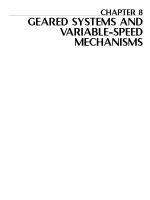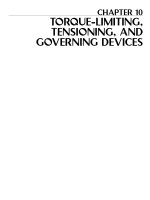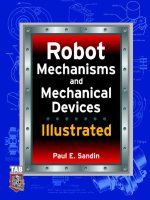McGraw-Hill - Robot Mechanisms and Mechanical Devices Illustrated - 2003 Part 12 doc
Bạn đang xem bản rút gọn của tài liệu. Xem và tải ngay bản đầy đủ của tài liệu tại đây (530.29 KB, 25 trang )
Chapter 10 Manipulator Geometries
Copyright © 2003 by The McGraw-Hill Companies, Inc. Click here for Terms of Use.
This page intentionally left blank.
M
anipulator is a fancy name for a mechanical arm. A manipulator is
an assembly of segments and joints that can be conveniently
divided into three sections: the arm, consisting of one or more segments
and joints; the wrist, usually consisting of one to three segments and
joints; and a gripper or other means of attaching or grasping. Some texts
on the subject divide manipulators into only two sections, arm and grip-
per, but for clarity the wrist is separated out as its own section because it
performs a unique function.
Industrial robots are stationary manipulators whose base is perma-
nently attached to the floor, a table, or a stand. In most cases, however,
industrial manipulators are too big, use a geometry that is not effective
on a mobile robot, or lack enough sensors -(indeed many have no envi-
ronmental sensors at all) to be considered for use on a mobile robot.
There is a section covering them as a group because they demonstrate a
wide variety of sometimes complex manipulator geometries. The chap-
ter’s main focus, however, will be on the three general layouts of the arm
section of a generic manipulator, and wrist and gripper designs. A few
unusual manipulator designs are also included.
It should be pointed out that there are few truly autonomous manipu-
lators in use except in research labs. The task of positioning, orienting,
and doing something useful based solely on input from frequently inade-
quate sensors is extremely difficult. In most cases, the manipulator is
teleoperated. Nevertheless, it is theoretically possible to make a truly
autonomous manipulator and their numbers are expected to increase dra-
matically over the next several years.
POSITIONING, ORIENTING, HOW MANY
DEGREES OF FREEDOM?
In a general sense, the arm and wrist of a basic manipulator perform two
separate functions, positioning and orienting. There are layouts where
the wrist or arm are not distinguishable, but for simplicity, they are
treated as separate entities in this discussion. In the human arm, the
241
242 Chapter 10 Manipulator Geometries
shoulder and elbow do the gross positioning and the wrist does the ori-
enting. Each joint allows one degree of freedom of motion. The theoreti-
cal minimum number of degrees of freedom to reach to any location in
the work envelope and orient the gripper in any orientation is six; three
for location, and three for orientation. In other words, there must be at
least three bending or extending motions to get position, and three twist-
ing or rotating motions to get orientation.
Actually, the six or more joints of the manipulator can be in any order,
and the arm and wrist segments can be any length, but there are only a
few combinations of joint order and segment length that work effec-
tively. They almost always end up being divided into arm and wrist. The
three twisting motions that give orientation are commonly labeled pitch,
roll, and yaw, for tilting up/down, twisting, and bending left/right respec-
tively. Unfortunately, there is no easy labeling system for the arm itself
since there are many ways to achieve gross positioning using extended
segments and pivoted or twisted joints. A generally excepted generic
description method follows.
A good example of a manipulator is the human arm, consisting of a
shoulder, upper arm, elbow, and wrist. The shoulder allows the upper
arm to move up and down which is considered one DOF. It allows for-
ward and backward motion, which is the second DOF, but it also allows
rotation, which is the third DOF. The elbow joint gives the forth DOF.
The wrist pitches up and down, yaws left and right, and rolls, giving
three DOFs in one joint. The wrist joint is actually not a very well
designed joint. Theoretically the best wrist joint geometry is a ball joint,
but even in the biological world, there is only one example of a true full
motion ball joint (one that allows motion in two planes, and twists 360°)
because they are so difficult to power and control. The human hip joint is
a limited motion ball joint.
On a mobile robot, the chassis can often substitute for one or two of
the degrees of freedom, usually fore/aft and sometimes to yaw the arm
left/right, reducing the complexity of the manipulator significantly.
Some special purpose manipulators do not need the ability to orient the
gripper in all three axes, further reducing the DOF. At the other extreme,
there are arms in the conceptual stage that have more than fifteen DOF.
To be thorough, this chapter will include the geometries of all the
basic three DOF manipulator arms, in addition to the simpler two DOF
arms specifically for use on robots. Wrists are shown separately. It is left
to you to pick and match an effective combination of wrist and arm
geometries to solve your specific manipulation problem. First, let’s look
at an unusual manipulator and a simple mechanism—perhaps the sim-
plest mechanism for creating linear motion from rotary motion.
Chapter 10 Manipulator Geometries 243
E-Chain
An unusual chain-like device can be used as a manipulator. It is based on
a flexible cable bundle carrier called E-Chain and has unique properties.
The chain can be bent in only one plane, and to only one side. This
allows it to cantilever out flat creating a long arm, but stored rolled up
like a tape measure. It can be used as a one-DOF extension arm to reach
into small confined spaces like pipes and tubes. Figure 10-1 shows a
simplified line drawing of E-chain’s allowable motion.
Slider Crank
The slider-crank (Figure 10-2) is usually used to get rotary motion from
linear motion, as in an internal combustion engine, but it is also an effi-
cient way to get linear motion from the rotary motion of a motor/gear-
box. A connecting rod length to / crank radius ratio of four to one pro-
duces nearly linear motion of the slider over most of its stroke and is,
therefore, the most useful ratio. Several other methods exist for creating
Figure 10-1 E-chain
244 Chapter 10 Manipulator Geometries
linear motion from rotary, but the slider crank is particularly effective for
use in walking robots.
The motion of the slider is not linear in velocity over its full range of
motion. Near the ends of its stroke the slider slows down, but the force
produced by the crank goes up. This effect can be put to good use as a
clamp. It can also be used to move the legs of walkers. The slider crank
should be considered if linear motion is needed in a design.
Figure 10-2 Slider Crank
Chapter 10 Manipulator Geometries 245
In order to put the slider crank to good use, a method of calculating
the position of the slider relative to the crank is helpful. The equation for
calculating how far the slider travels as the crank arm rotates about the
motor/gearbox shaft is: x = L cos Ø+ r cos Ø.
ARM GEOMETRIES
The three general layouts for three-DOF arms are called Cartesian, cylin-
drical, and polar (or spherical). They are named for the shape of the vol-
ume that the manipulator can reach and orient the gripper into any posi-
tion—the work envelope. They all have their uses, but as will become
apparent, some are better for use on robots than others. Some use all slid-
ing motions, some use only pivoting joints, some use both. Pivoting
joints are usually more robust than sliding joints but, with careful design,
sliding or extending can be used effectively for some types of tasks.
Pivoting joints have the drawback of preventing the manipulator from
reaching every cubic centimeter in the work envelope because the elbow
cannot fold back completely on itself. This creates dead spaces—places
where the arm cannot reach that are inside the gross work volume. On a
robot, it is frequently required for the manipulator to fold very com-
pactly. Several manipulator manufacturers use a clever offset joint
design depicted in Figure 10-3 that allows the arm to fold back on itself
Figure 10-3 Offset joint
increases working range of
pivoting joints
246 Chapter 10 Manipulator Geometries
180°. This not only reduces the stowed volume,
but also reduces any dead spaces. Many indus-
trial robots and teleoperated vehicles use this or a
similar design for their manipulators.
CARTESIAN OR RECTANGULAR
On a mobile robot, the manipulator almost
always works beyond the edge of the chassis and
must be able to reach from ground level to above
the height of the robot’s body. This means the
manipulator arm works from inside or from one
side of the work envelope. Some industrial gantry
manipulators work from outside their work enve-
lope, and it would be difficult indeed to use their
layouts on a mobile robot. As shown in Figure
10-4, gantry manipulators are Cartesian or rec-
tangular manipulators. This geometry looks like
a three dimensional XYZ coordinate system. In
fact, that is how it is controlled and how the
working end moves around in the work envelope.
There are two basic layouts based on how the
Figure 10-4 Gantry, simply
supported using tracks or slides,
working from outside the work
envelope.
Figure 10-5 Cantilevered manipulator geometry
Chapter 10 Manipulator Geometries 247
arm segments are supported, gantry and can-
tilevered.
Mounted on the front of a robot, the first two
DOF of a cantilevered Cartesian manipulator can
move left/right and up/down; the Y-axis is not
necessarily needed on a mobile robot because the
robot can move back/forward. Figure 10-5 shows
a cantilevered layout with three DOF. Though not
the best solution to the problem of working off
the front of a robot, it will work. It has the benefit
of requiring a very simple control algorithm.
CYLINDRICAL
The second type of manipulator work envelope is
cylindrical. Cylindrical types usually incorporate
a rotating base with the first segment able to tele-
scope or slide up and down, carrying a horizon-
tally telescoping segment. While they are very
simple to picture and the work envelope is fairly
intuitive, they are hard to implement effectively
because they require two linear motion segments,
both of which have moment loads in them caused
by the load at the end of the upper arm.
In the basic layout, the control code is fairly
simple, i.e., the angle of the base, height of the
first segment, and extension of the second seg-
ment. On a robot, the angle of the base can sim-
ply be the angle of the chassis of the robot itself,
leaving the height and extension of the second
segment. Figure 10-6 shows the basic layout of a
cylindrical three-DOF manipulator arm.
A second geometry that still has a cylindrical
work envelope is the SCARA design. SCARA
means Selective Compliant Assembly Robot
Arm. This design has good stiffness in the verti-
cal direction, but some compliance in the hori-
zontal. This makes it easier to get close to the
right location and let the small compliance take
up any misalignment. A SCARA manipulator
replaces the second telescoping joint with two
vertical axis-pivoting joints. Figure 10-7 shows a
SCARA manipulator.
Figure 10-6 Three-DOF cylindrical manipulator
Figure 10-7 A SCARA manipulator
248 Chapter 10 Manipulator Geometries
POLAR OR SPHERICAL
The third, and most versatile, geometry is the
spherical type. In this layout, the work envelope
can be thought of as being all around. In real-
ity, though, it is difficult to reach everywhere.
There are several ways to layout an arm with
this work envelope. The most basic has a rotat-
ing base that carries an arm segment that can
pitch up and down, and extend in and out
(Figure 10-8). Raising the shoulder up (Figure
10-9) changes the envelope somewhat and is
worth considering in some cases. Figures 10-10,
10-11, and 10-12 show variations of the spher-
ical geometry manipulator.
Figure 10-8 Basic polar
coordinate manipulator
Figure 10-9 High shoulder
polar coordinate manipulator
with offset joint at elbow
Chapter 10 Manipulator Geometries 249
Figure 10-10 High shoulder polar coordinate manipulator
with overlapping joints
Figure 10-11 Articulated polar coordinate manipulator
Figure 10-12 Gun turret polar
coordinate manipulator
250 Chapter 10 Manipulator Geometries
THE WRIST
The arm of the manipulator only gets the end point in the right place. In
order to orient the gripper to the correct angle, in all three axes, a second
set of joints is usually required—the wrist. The joints in a wrist must
twist up/down, clockwise/counter-clockwise, and left/right. They must
pitch, roll, and yaw respectively. This can be done all-in-one using a ball-
in-socket joint like a human hip, but controlling and powering this type is
difficult.
Most wrists consist of three separate joints. Figures 10-13, 10-14, and
10-15 depict one, two, and three-DOF basic wrists each building on the
previous design. The order of the degrees of freedom in a wrist has a
large effect on the wrist’s functionality and should be chosen carefully,
especially for wrists with only one or two DOF.
Figure 10-13 Single-DOF wrist
(yaw)
Chapter 10 Manipulator Geometries 251
Figure 10-14 Two-DOF wrist
(yaw and roll)
Figure 10-15 Three-DOF wrist
(yaw, roll, and pitch)
252 Chapter 10 Manipulator Geometries
GRIPPERS
The end of the manipulator is the part the user or robot uses to affect
something in the environment. For this reason it is commonly called an
end-effector, but it is also called a gripper since that is a very common
task for it to perform when mounted on a robot. It is often used to pick up
dangerous or suspicious items for the robot to carry, some can turn door-
knobs, and others are designed to carry only very specific things like
beer cans. Closing too tightly on an object and crushing it is a major
problem with autonomous grippers. There must be some way to tell how
hard is enough to hold the object without dropping it or crushing it. Even
for semi-autonomous robots where a human controls the manipulator,
using the gripper effectively is often difficult. For these reasons, gripper
design requires as much knowledge as possible of the range of items the
gripper will be expected to handle. Their mass, size, shape, and strength,
etc. all must be taken into account. Some objects require grippers that
have many jaws, but in most cases, grippers have only two jaws and
those will be shown here.
There are several basic types of gripper geometries. The most basic
type has two simple jaws geared together so that turning the base of one
Figure 10-16 Simple direct
drive swinging jaw
Chapter 10 Manipulator Geometries 253
turns the other. This pulls the two jaws together. The jaws can be moved
through a linear actuator or can be directly mounted on a motor gear-
box’s output shaft (Figure 10-16), or driven through a right angle drive
(Figure 10-17) which places the drive motor further out of the way of the
gripper. This and similar designs have the drawback that the jaws are
always at an angle to each other which tends to push the thing being
grabbed out of the jaws.
Figure 10-17 Simple direct
drive through right angle worm
drive gearmotor
Figure 10-18 Rack and pinion drive gripper Figure 10-19 Reciprocating lever gripper
254 Chapter 10 Manipulator Geometries
A more effective jaw layout is the parallel jaw gripper. One possible
layout adds a few more links to the basic two fingers to form a four-bar
linkage which holds the jaws parallel to each other easing the sometimes
very difficult task of keeping the thing being grabbed in the gripper until
it closes. Another way to get parallel motion is to use a linear actuator to
move one or both jaws directly towards and away from each other. These
layouts are shown in Figures 10-21, 10-22, and 10-23.
Figure 10-20 Linear actuator
direct drive gripper
Figure 10-21 Parallel jaw on
linear slides
Chapter 10 Manipulator Geometries 255
PASSIVE PARALLEL JAW USING CROSS TIE
Twin four-bar linkages are the key components in this long mechanism
that can grip with a constant weight-to-grip force ratio any object that fits
Figure 10-22 Parallel jaw using
four-bar linkage
Figure 10-23 Parallel jaw using
four-bar linkage and linear
actuator
256 Chapter 10 Manipulator Geometries
within its grip range. The long mechanism relies on a cross-tie between
the two sets of linkages to produce equal and opposite linkage move-
ment. The vertical links have extensions with grip pads mounted at their
ends, while the horizontal links are so proportioned that their pads move
in an inclined straight-line path. The weight of the load being lifted,
therefore, wedges the pads against the load with a force that is propor-
tional to the object’s weight and independent of its size.
Some robots are designed to do one specific task, to carry one specific
object, or even to latch onto some specific thing. Installing a dedicated
knob or ball end on the object simplifies the gripping task using this mat-
ing one-way connector. In many cases, a joint like this can be used inde-
pendently of any manipulator.
PASSIVE CAPTURE JOINT WITH THREE
DEGREES OF FREEDOM
New joint allows quick connection between any two
structural elements where rotation in all three axes is
desired.
Marshall Space Flight Center, Alabama
A new joint, proposed for use on an attachable debris shield for the
International Space Station Service Module, has potential for commer-
Figure 10-24 Passive parallel
jaw using cross tie
Chapter 10 Manipulator Geometries 257
cial use in situations where hardware must be assembled and disassem-
bled on a regular basis.
This joint can be useful in a variety of applications, including replac-
ing the joints commonly used on trailer-hitch tongues and temporary
structures, such as crane booms and rigging. Other uses for this joint
include assembly of structures where simple rapid deployment is essen-
tial, such as in space, undersea, and in military structures.
This new joint allows for quick connection between any two structural
elements where it is desirable to have rotation in all three axes. The joint
can be fastened by moving the two halves into position. The joint is then
connected by inserting the ball into the bore of the base. When the joint
ball is fully inserted, the joint will lock with full strength. Release of this
joint involves only a simple movement and rotation of one part. The joint
can then be easily separated.
Most passive capture devices allow only axial rotation when fas-
tened—if any movement is allowed at all. Manually- or power-actuated
active joints require an additional action, or power and control signal, as
well as a more complex mechanism.
The design for this new joint is relatively simple. It consists of two
halves, a ball mounted on a stem (such as those on a common trailer-
hitch ball) and a socket. The socket contains all the moving parts and is
the important part of this invention. The socket also has a base, which
contains a large central cylindrical bore ending in a spherical cup.
This work was done by Bruce Weddendorf and Richard A. Cloyd of the
Marshall Space Flight Center.
Figure 10-25 The three-
degrees-of-freedom capability of
the passive capture joint provides
for quick connect and disconnect
operations.
258 Chapter 10 Manipulator Geometries
INDUSTRIAL ROBOTS
The programmability of the industrial industrial robot using computer
software makes it both flexible in the way it works and versatile in the
range of tasks it can accomplish. The most generally accepted definition
of an industrial robot is a reprogrammable, multi-function manipulator
designed to move material, parts, tools, or specialized devices through
variable programmed motions to perform a variety of tasks. Industrial
robots can be floor-standing, benchtop, or mobile.
Industrial robots are classified in ways that relate to the characteristics
of their control systems, manipulator or arm geometry, and modes of
operation. There is no common agreement on or standardizations of
these designations in the literature or among industrial robot specialists
around the world.
A basic industrial robot classification relates to overall performance
and distinguishes between limited and unlimited sequence control. Four
classes are generally recognized: limited sequence and three forms of
unlimited sequence—point-to-point, continuous path, and controlled
path. These designations refer to the path taken by the end effector, or
tool, at the end of the industrial robot arm as it moves between operations.
Another classification related to control is nonservoed versus servoed.
Nonservoed implies open-loop control, or no closed-loop feedback, in
the system. By contrast, servoed means that some form of closed-loop
feedback is used in the system, typically based on sensing velocity, posi-
tion, or both. Limited sequence also implies nonservoed control while
unlimited sequence can be achieved with point-to-point, continuous-
path, or controlled-path modes of operation.
Industrial robots are powered by electric, hydraulic, or pneumatic
motors or actuators. Electric motor power is most popular for the major
axes of floor-standing industrial industrial robots today. Hydraulic-drive
industrial robots are generally assigned to heavy-duty lifting applica-
tions. Some electric and hydraulic industrial robots are equipped with
pneumatic-controlled tools or end effectors.
The number of degrees of freedom is equal to the number of axes of
an industrial robot, and is an important indicator of its capability.
Limited-sequence industrial robots typically have only two or three
degrees of freedom, but point-to-point, continuous-path, and controlled-
path industrial robots typically have five or six. Two or three of those
may be in the wrist or end effector.
Most heavy-duty industrial robots are floor-standing. Others in the
same size range are powered by hydraulic motors. The console contains
a digital computer that has been programmed with an operating system
and applications software so that it can perform the tasks assigned to it.
Chapter 10 Manipulator Geometries 259
Some industrial robot systems also include training pendants—handheld
pushbutton panels connected by cable to the console that permit direct
control of the industrial robot .
The operator or programmer can control the movements of the indus-
trial robot arm or manipulator with pushbuttons or other data input
devices so that it is run manually through its complete task sequence to
program it. At this time adjustments can be made to prevent any part of
the industrial robot from colliding with nearby objects.
There are also many different kinds of light-duty assembly or pick-
and-place industrial robots that can be located on a bench. Some of these
are programmed with electromechanical relays, and others are pro-
grammed by setting mechanical stops on pneumatic motors.
Industrial Robot Advantages
The industrial robot can be programmed to perform a wider range of tasks
than dedicated automatic machines, even those that can accept a wide
selection of different tools. However, the full benefits of an industrial robot
can be realized only if it is properly integrated with the other machines
human operators, and processes. It must be evaluated in terms of cost-
effectiveness of the performance or arduous, repetitious, or dangerous
tasks, particularly in hostile environments. These might include high tem-
peratures, high humidity, the presence of noxious or toxic fumes, and
proximity to molten metals, welding arcs, flames, or high-voltage sources.
The modern industrial robot is the product of developments made in
many different engineering and scientific disciplines, with an emphasis
on mechanical, electrical, and electronic technology as well as computer
science. Other technical specialties that have contributed to industrial
robot development include servomechanisms, hydraulics, and machine
design. The latest and most advanced industrial robots include dedicated
digital computers.
The largest number of industrial robots in the world are limited-
sequence machines, but the trend has been toward the electric-motor
powered, servo-controlled industrial robots that typically are floor-
standing machines. Those industrial robots have proved to be the most
cost-effective because they are the most versatile.
Trends in Industrial Robots
There is evidence that the worldwide demand for industrial robots has
yet to reach the numbers predicted by industrial experts and visionaries
260 Chapter 10 Manipulator Geometries
some twenty years ago. The early industrial robots were expensive and
temperamental, and they required a lot of maintenance. Moreover, the
software was frequently inadequate for the assigned tasks, and many
industrial robots were ill-suited to the tasks assigned them.
Many early industrial customers in the 1970s and 1980s were disap-
pointed because their expectations had been unrealistic; they had
underestimated the costs involved in operator training, the preparation
of applications software, and the integration of the industrial robots
with other machines and processes in the workplace.
By the late 1980s, the decline in orders for industrial robots drove
most American companies producing them to go out of business, leav-
ing only a few small, generally unrecognized manufacturers. Such
industrial giants as General Motors, Cincinnati Milacron, General
Electric, International Business Machines, and Westinghouse entered
and left the field. However, the Japanese electrical equipment manufac-
turer Fanuc Robotics North America and the Swedish-Swiss corpora-
tion Asea Brown Boveri (ABB) remain active in the U.S. robotics mar-
ket today.
However, sales are now booming for less expensive industrial robots
that are stronger, faster, and smarter than their predecessors. Industrial
robots are now spot-welding car bodies, installing windshields, and
doing spray painting on automobile assembly lines. They also place and
remove parts from annealing furnaces and punch presses, and they
assemble and test electrical and mechanical products. Benchtop indus-
trial robots pick and place electronic components on circuit boards in
electronics plants, while mobile industrial robots on tracks store and
retrieve merchandise in warehouses.
The dire predictions that industrial robots would replace workers in
record numbers have never been realized. It turns out that the most cost-
effective industrial robots are those that have replaced human beings in
dangerous, monotonous, or strenuous tasks that humans do not want to
do. These activities frequently take place in spaces that are poorly venti-
lated, poorly lighted, or filled with noxious or toxic fumes. They might
also take place in areas with high relative humidity or temperatures that
are either excessively hot or cold. Such places would include mines,
foundries, chemical processing plants, or paint-spray facilities.
Management in factories where industrial robots were purchased and
installed for the first time gave many reasons why they did this despite
the disappointments of the past twenty years. The most frequent reasons
were the decreasing cost of powerful computers as well as the simplifi-
cation of both the controls and methods for programming the computers.
This has been due, in large measure, to the declining costs of more pow-
Chapter 10 Manipulator Geometries 261
erful microprocessors, solid-state and disk memory, and applications
software.
However, overall system costs have not declined, and there have been
no significant changes in the mechanical design of industrial robots dur-
ing the industrial robot’s twenty-year “learning curve” and maturation
period.
The shakeout of American industrial robot manufacturers has led to
the near domination of the world market for industrial robots by the
Japanese manufacturers who have been in the market for most of the past
twenty years. However, this has led to de facto standardization in indus-
trial robot geometry and philosophy along the lines established by the
Japanese manufacturers. Nevertheless, industrial robots are still avail-
able in the same configurations that were available fifteen to twenty
years ago, and there have been few changes in the design of the end-use
tools that mount on the industrial robot’s “hand” for the performance of
specific tasks (e.g., parts handling, welding, painting).
Industrial Robot Characteristics
Load-handling capability is one of the most important factors in an
industrial robot purchasing decision. Some can now handle payloads of
as much as 200 pounds. However, most applications do not require the
handling of parts that are as heavy as 200 pounds. High on the list of
other requirements are “stiffness”—the ability of the industrial robot to
perform the task without flexing or shifting; accuracy—the ability to
perform repetitive tasks without deviating from the programmed dimen-
sional tolerances; and high rates of acceleration and deceleration.
The size of the manipulator or arm influences accessibility to the
assigned floor space. Movement is a key consideration in choosing an
industrial robot. The industrial robot must be able to reach all the parts or
tools needed for its application. Thus the industrial robot’s working
range or envelope is a critical factor in determining industrial robot size.
Most versatile industrial robots are capable of moving in at least five
degrees of freedom, which means they have five axes. Although most
tasks suitable for industrial robots today can be performed by industrial
robots with at least five axes, industrial robots with six axes (or degrees
of freedom) are quite common. Rotary base movement and both radial
and vertical arm movement are universal. Rotary wrist movement and
wrist bend are also widely available. These movements have been desig-
nated as roll and pitch by some industrial robot manufacturers. Wrist
yaw is another available degree of freedom.
262 Chapter 10 Manipulator Geometries
More degrees of freedom or axes can be added externally by installing
parts-handling equipment or mounting the industrial robot on tracks or
rails so that it can move from place to place. To be most effective, all
axes should be servo-driven and controlled by the industrial robot’s com-
puter system.
Chapter 11 Proprioceptive and
Environmental Sensing
Mechanisms and Devices
Copyright © 2003 by The McGraw-Hill Companies, Inc. Click here for Terms of Use.









